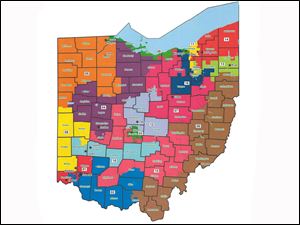
2 Ohio primary dates OK'd; district maps still disputed
10/22/2011
Democrats met to establish a united fronti n their demands to the Republican majority, including reuniting cities such as Toledo which are divided among multiple districts bolstering majority voting clout in urban areas.
COLUMBUS -- The Republican-controlled Ohio House last night ratified a plan to hold two primary elections next year in March and June, but did not strike a deal with Democrats to resolve a Statehouse stalemate over congressional district lines.
Democratic leaders met to establish a united front in their demands to the Republican majority. Those include reuniting cities such as Toledo that are divided among multiple districts, bolstering minority voting clout in urban areas, and keeping more counties wholly intact than the current GOP map does.
The pressure increased on the talks Friday as Attorney General Mike DeWine approved the petition language that Democrats plan to show registered voters as they gather signatures to subject the GOP-passed map to a referendum on the November, 2012, ballot.
House Speaker Bill Batchelder (R., Medina) said talks have progressed, but that both sides remain far apart. He said Republicans may be better off taking their chances with federal courts than accepting what Democrats have offered.
"I'm not sure, based on what either side has said, that there is ground for consensus, but I don't want to rule that out until we all get together [again] and have a go at it," he said.
No talks were scheduled for the weekend.
"There has always been an indication that the legislature should act in the bests interests of Ohioans, whether they come from Toledo, Cleveland, or Columbus," Ohio Democratic Party Chairman Chris Redfern said. "That remains true to this day. The question is whether Republicans are willing to sit down and compromise on a map that fully reflects Ohioans."
But first the current map has to go, Mr. Redfern said. There can be "no tinkering" with the existing map as Republican leaders have said is their preference.
"The Republicans butchered Lucas County by subdividing it into three congressional districts," said Rep. Matt Szollosi (D., Oregon), the No. 2 Democrat in the chamber. "Any compromise is going to require restoration of Lucas County in one district so that we can maintain our strong voice in Washington."
To buy the time for the talks, the House voted 55-37, nearly along party lines, to postpone until June 12 the primary for president, U.S. House of Representatives, and political party delegates because they are tied to congressional district lines.
But the election for local races, U.S. Senate, state House and Senate, and Ohio Supreme Court remain scheduled for March 6, as required under current law. The August special election, in which voters typically decided local tax levies, will be merged with the June primary.
The state has promised to reimburse county boards of elections for the cost of doubling their efforts next spring. The price tag is expected to be about $15 million. Gov. John Kasich was expected to sign the measure into law swiftly.
Mr. Batchelder, however, said that if a deal can be struck soon on a new map that would not be delayed by referendum, an amendment could be added to that bill to change the election calendar again.
To demonstrate that the Democratic Party has the infrastructure in place to succeed in gathering the minimum 231,147 signatures needed by late December to put the map on the ballot, the party reported Friday it had gathered 150,000 more signatures in 17 days to put House Bill 194, an election process overhaul law, on the November, 2012, ballot. It had already filed 318,460.
Contact Jim Provance at: jprovance@theblade.com or 614-221-0496.